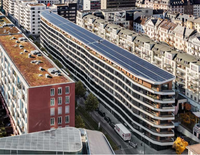What's BIPV?
The integration of solar modules (that generate electricity from sunlight) into the envelope of a building or other structure is called "building-integrated photovoltaics", or BIPV for short.
The term integration is used when such a solar module also becomes part of the building and replaces another element of the building envelope. Depending on the definition, this can purely be a design function, but also primarily a structural function. The solar module becomes a multifunctional building element and, in addition to generating electricity, also takes on other functions, such as weather protection, shading or noise protection.
Through its integration, the solar module becomes an integral part of the building. It must fulfill both the technical functionality as a solar and as a construction element, as well as - and this is particularly important - integrating itself aesthetically into the building. BIPV modules must therefore also primarily meet design requirements such as color, transparency, shape and, to a certain extent, materiality.
Integration of photovoltaics into a building
Schematic illustration of the various options for integrating photovoltaics into a building envelope © HZB (2025)
Challenges for multifunctional BIPV elements:
- Customer-specific solutions (dimensions, shapes, transparency, colors, ...)
- Easily plannable and cost-effective standard elements (e.g. for BIM)
- Integration into innovative facade elements
- Combination of building materials & electricity-producing elements
- Application-specific properties (tolerance of recurring (partial) shading)
- Legal aspects (materials, glare, safety, ...)
- Certification and testing, approvals
- Partnerships required with the construction industry (module manufacturers are usually not a direct contractual partner on the construction site)
Challenges for architecture and building owners:
- Obtaining information about design and technical possibilities and boundary conditions
- Use further education
- Reduce reservations
- Accepting changes in the planning process (in terms of time and content, HOAI)
- Recognizing and accepting opportunities and responsibility
Challenges for the trade:
Who is responsible for the installation of building-integrated photovoltaics?
The facade builder and/or the roofer.
- PV becomes part of the scope of services
- More subcontractors or extended expertise in the building
- Roof/ facade installation partnerships - keyword solar installer
- Extended planning tasks
- Changed liability and warranty
- New business models
- Local value chain
Examples of different ways to integrate photovoltaics
AktivhausPlus FFM (HHS)
Example 1: Aktiv-Stadthaus in Frankfurt am Main with aesthetically integrated solar modules in the roof and fully integrated facade elements (HHS Planer und Architekten, photo: Constantin Meyer Photografie).
PV Lamellas ZPV (BR)
Example 2: Solar modules as shading elements, aesthetically integrated. Center for Photovoltaics and Renewable Energies (ZPV) in Berlin-Adlershof (Henn Architekten, Foto: B. Rau, HZB)
Balcony railing (TK)
Example 3: Solar modules as a balcony railing of a Swiss apartment building in Altstetten (Zurich) serve both as mechanical fall protection and as power-generating elements (Kämpfen für Architektur, Foto: T. Kühn, HZB)
_1.png/picture-200?_=198ac9ff1a0)
